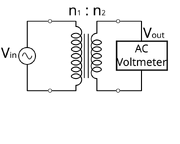No edit summary |
(Updated via Administrative Bot.) |
||
| Line 25: | Line 25: | ||
Measure the inductance of each winding with all other windings open circuit. |
Measure the inductance of each winding with all other windings open circuit. |
||
| − | * L<sub>m1</sub>/L<sub>m2</sub> = n<sub>1</sub>:n<sub>2</sub> |
+ | * L<sub>m1</sub>/L<sub>m2</sub> = n<sub>1</sub>:n<sub>2</sub><div id="wikia-credits"><br /><br /><small>From [http://howto.wikia.com HowTo Wiki], a [http://www.wikia.com Wikia] wiki.</small></div> |
| + | |||
| + | |||
| + | |||
| + | [[Category:Howto]] |
||
Revision as of 02:09, 20 July 2008

Symbol of a transformer
The turns ratio of a transformer is the ratio of number of windings of each side of the transformer. Sometimes you wish to find out the turns ratio of an unlabeled transform.
The transformer turns ration is labeled as follows:
- n1:n2
Transformers can have multiple windings for multiple Voltages. Generally it is specified by:
- n1:n2
- n1:n3
Measuring Voltage to find ratio

Symbol of a transformer
A transformer converts one AC Voltage to another. So inputing an AC Voltage and measuring the output Voltage will give you the turns ratio.
- Vin/Vout = n1:n2
Something to be cautious about is creating too high of a voltage, for the insulation of the wire in the winding. This will cause a short, and bad news. For instance, say you input 120V and the turns ratio is 1:100, then the output would be 12kV
The best method is to get a low voltage AC source and connect it to the wires with the most windings. If the output Voltage is too low to get an accurate measurement, then you just add a higher Voltage.
Measuring inductance to find ratio

Measure inductance
If you are lucky enough LCR meter, inductance/capacitance/resistance meter, or an inductance meter you can find the inductance of each winding, and the turns ratio.
Measure the inductance of each winding with all other windings open circuit.
- Lm1/Lm2 = n1:n2